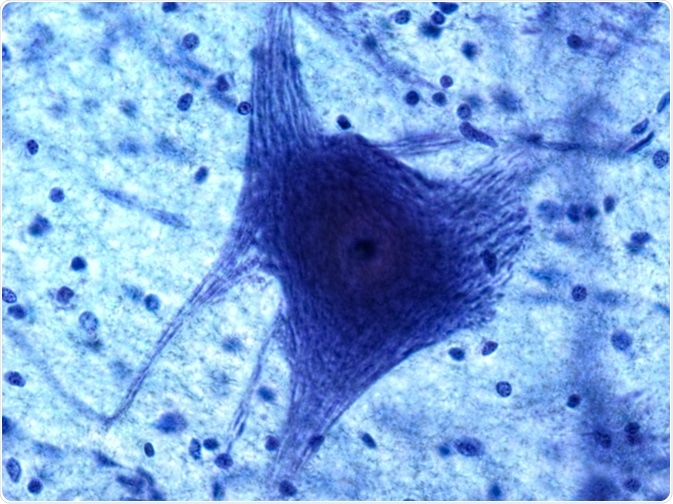Gliogenesis is the generation of glial cells (non-neuronal cells) in the nervous system (both central and peripheral nervous systems).

Image Credit: Christopher Meade/Shutterstock.com
Gliogenesis occurs as a result of multipotent neural stem cells differentiating down a glial lineage, rather than a neuronal lineage. Impaired gliogenesis is associated with neurodevelopmental, neurodegenerative, psychiatric & glial tumorigenesis.
What are Glial Cells?
Glial cells, or glia, are non-neuronal cell types found within the nervous system which are typically involved in a range of functions including providing metabolic and trophic support for neurons, production of myelin, play an immune role, and to participate in neuronal homeostatic mechanisms.
Along with neurons and vessels, they also form a part of the neurovascular unit and components of the blood-brain-barrier.
The main glial cell types include macroglia (astrocytes, oligodendrocytes), microglia, as well as Schwann cells (in the PNS).
How Does Gliogenesis Occur?
During early development, soon after the production of multipotent neural stem cells, which can differentiate into either neurons or glia, are subjected to various molecular signaling factors that determine their fate.
The process of gliogenesis is not only conserved across mammals but across vertebrate and invertebrate species, thus studying the mechanisms of gliogenesis can be achieved using simple invertebrate organisms such as Drosophila, in addition to vertebrates such as chicks and zebrafish – all which can be studies ex utero.
The first glial cells to become apparent in the developing brain are microglia which develop side by side neurons.
Microglia are derived from yolk-sac myeloid progenitor cells which quickly colonize the developing brain alongside neurogenesis (the formation of neurons) and account for the majority of microglia found in the adult brain.
Macroglia, in addition to excitatory neurons, are derived from radial glial cells (RGCs); a form of multipotent neural stem cell that originates in the early ventricular zone (VZ). These are the second type of glial cells to enter the brain.
In mammals, cells derived from RGCs form progenitor cells that migrate and populate the subventricular zone (SVZ) which is larger and more complex in primates, but much simpler and smaller in rodents, for example.
In higher-order mammals, the SVZ can be divided into an inner-SVZ (iSVZ) and outer-SVZ (oSVZ) separated by a thin fiber layer. Studies have shown that gliogenesis in the oSVZ leads to the enlargement and gyrification of some primate brains, including humans.
RGCs form neural progenitor cells (NPCs) that can either form neurons through a neural lineage (PDGF/EGF-) or a glial lineage; BMP CNTF & NG2 to form astrocytes, or PDGFaR, FGF, Shh, Olig2, EGF and BMP- to form oligodendrocytes.
However, astrocytes can be reprogrammed into a neural fate with the influence of Pax6, Sox-2+VPA, Sox2-BDNF+noggin.
Throughout adulthood, parenchymal progenitors maintain a slow and small level of gliogenesis especially concerning oligodendrocyte renewal (oligodendrocyte progenitor cells; OPCs). In response to disease, infection, and injury, they become more active.
Similarly, astrocytes are capable of proliferation (astrogliosis) in the adult brain when presented with brain injury, inflammation, infection, or disease.
The fact that astrocytes retain the ability to be reprogrammed (as discussed) suggests they are somewhat multipotent, even in the adult brain. However, in vivo, astrocytes do not typically change their fate.
Impairments to Gliogenesis
Abnormal gliogenesis at any stage of life is associated with many neurodegenerative, neurodevelopmental, neuropsychiatric, and tumorigenesis in the nervous system.
For example, recent studies have shown that lesions within the SVZ which extend to the lateral ventricles are associated with immune cell infiltration of the gliogenic regions to initiate neuroinflammation, which leads to a reduction of the progenitor cell populations.
As such, a reduced OPC population leads to reduced myelination renewal and is implicated in multiple sclerosis pathology.
In gliomas, a type of brain cancer, there is an uncontrolled gliogenesis that occurs characterized by a loss of contact inhibition, cellular migration, and unregulated mass proliferation.
Normally, cellular regulatory mechanisms prevent the mass uncontrolled gliogenesis from occurring (contact inhibition), however, due to genetic aberrations that occur in the onset of gliomas, these regulatory mechanisms fail leading to the proliferation of glial cells.
Since glial cells are necessary for neuronal survival, impaired gliogenesis, and aberrant signaling pathways that are implicated in a variety of conditions, they can become useful therapeutic targets.
For example, reprogramming of glial cells, amongst others in vitro, back to a progenitor fate to be directed down a neural, or glial fate to be used as a cellular transplantation-based therapy may be one option.
In the case of MS (as described), generating more OPCs and oligodendrocytes could deal with the issue of demyelination by enhanced production of myelin.
In summary, gliogenesis is the production of glial cells in the brain such as astrocytes, oligodendrocytes, and microglia, which all play a critical role in neuronal trophic support, nutrient transport and homeostasis, immunity as well as producing myelin.
Gliogenesis starts alongside neurogenesis in the early developing brain and most glial cells form from common multipotent neural precursor cells but get directed down a non-neuronal fate.
Impairments to gliogenesis or glial activity are implicated in a variety of neurological disorders, such as MS, and targeting impaired gliogenic mechanisms could serve to be important therapies in the future.
Last Updated: May 27, 2020